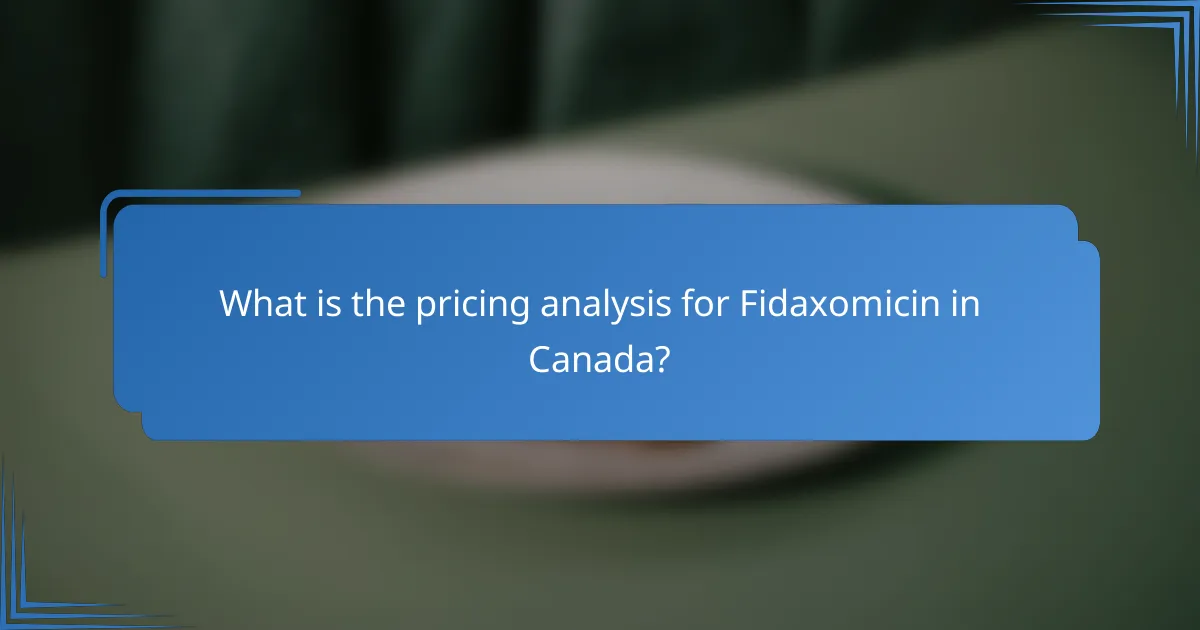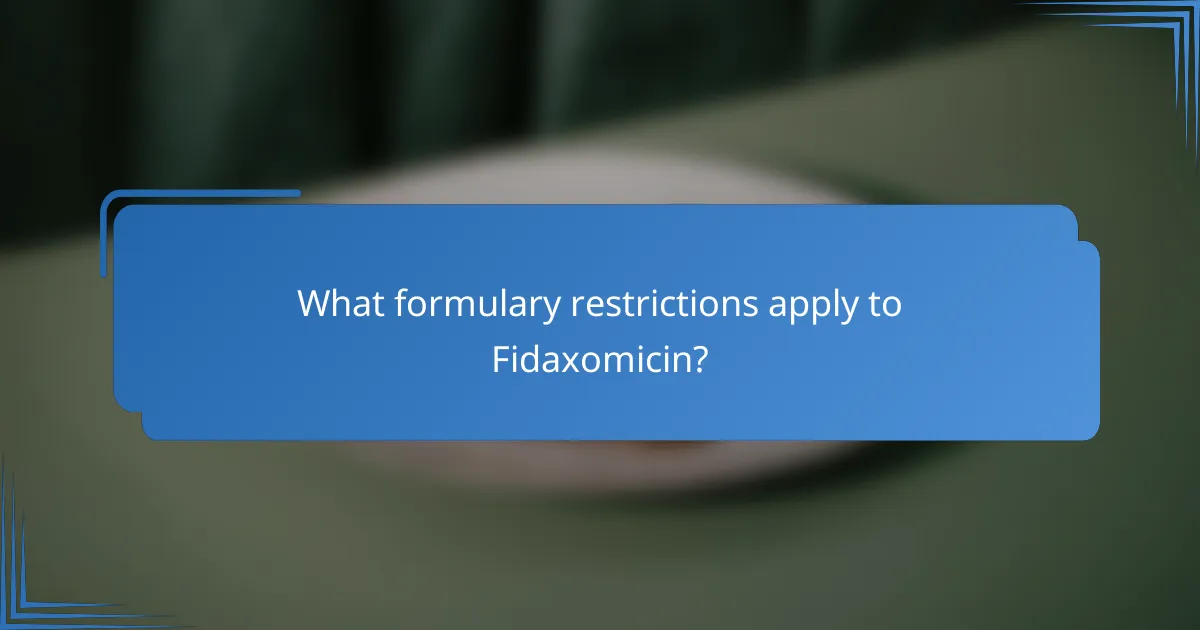Fidaxomicin is a costly antibiotic primarily used to treat Clostridioides difficile infections, making its pricing analysis essential for both healthcare providers and patients. Its availability can be impacted by formulary restrictions, which may include specific approval criteria and health plan coverage decisions. To ensure access while managing costs, healthcare facilities must develop effective procurement strategies that leverage pricing dynamics and negotiation tactics.

What is the pricing analysis for Fidaxomicin in Canada?
The pricing analysis for Fidaxomicin in Canada reveals that it is a relatively expensive antibiotic used primarily for treating Clostridioides difficile infections. Understanding its cost structure, insurance coverage, and available discounts is crucial for healthcare providers and patients alike.
Average retail price
The average retail price of Fidaxomicin in Canada typically ranges from CAD 1,500 to CAD 2,000 for a course of treatment. This price can vary based on the pharmacy and any applicable promotions or discounts.
Cost comparison with alternatives
When comparing Fidaxomicin to alternatives like Vancomycin, which may cost significantly less, it is essential to consider the efficacy and safety profiles. While Vancomycin can be priced around CAD 100 to CAD 300 for a similar treatment duration, Fidaxomicin may offer better outcomes for certain patients.
Insurance coverage impact
Insurance coverage for Fidaxomicin can vary widely among different plans in Canada. Some private insurers may cover a substantial portion of the cost, while public health plans might have restrictions or require prior authorization, impacting patient access.
Price variations across pharmacies
Price variations for Fidaxomicin can be significant across different pharmacies in Canada. Patients may find that local independent pharmacies offer lower prices compared to larger chain pharmacies, making it beneficial to shop around for the best deal.
Discount programs availability
Several pharmaceutical companies and patient assistance programs offer discounts or financial assistance for Fidaxomicin. Patients should inquire with their healthcare providers or directly with the manufacturer to explore available options that could reduce out-of-pocket expenses.

What formulary restrictions apply to Fidaxomicin?
Fidaxomicin may face various formulary restrictions that can affect its availability and use in treatment plans. These restrictions often include specific criteria for approval, limitations based on patient demographics, and coverage decisions by health plans.
Common formulary limitations
Formulary limitations for Fidaxomicin typically include restrictions based on the type of infection being treated, patient age, and previous treatment failures. Many health plans may prefer other antibiotics unless specific clinical criteria are met, which can limit access for some patients.
Additionally, some formularies may categorize Fidaxomicin as a non-preferred drug, leading to higher out-of-pocket costs for patients. This can discourage its use even when clinically indicated.
Provincial health plan coverage
In Canada, provincial health plans have varying policies regarding the coverage of Fidaxomicin. Some provinces may fully cover the medication under specific conditions, while others may only provide partial coverage or require patients to pay upfront costs.
For example, provinces like Ontario may include Fidaxomicin in their drug formulary, but only for patients who meet certain clinical guidelines, such as recurrent Clostridium difficile infections.
Prior authorization requirements
Many insurance plans require prior authorization for Fidaxomicin, which means healthcare providers must submit documentation justifying its use before the medication can be dispensed. This process can delay treatment and add administrative burdens for providers.
To navigate these requirements effectively, providers should familiarize themselves with the specific criteria outlined by the patient’s insurance plan and prepare comprehensive documentation to support the request. Common pitfalls include incomplete forms or insufficient clinical rationale, which can lead to denials.

How to develop effective procurement strategies for Fidaxomicin?
Developing effective procurement strategies for Fidaxomicin involves understanding pricing dynamics, leveraging bulk purchasing, and utilizing negotiation tactics. These strategies can help healthcare facilities optimize costs while ensuring access to this essential medication.
Bulk purchasing advantages
Bulk purchasing can significantly reduce the cost per unit of Fidaxomicin, making it a viable option for hospitals and clinics. By ordering larger quantities, facilities may negotiate better pricing terms and secure more favorable contracts with suppliers.
Additionally, bulk purchases can lead to improved inventory management, as facilities can maintain a steady supply of Fidaxomicin. This approach minimizes the risk of stockouts and ensures that patients receive timely treatment.
Negotiation tactics with suppliers
Effective negotiation tactics with suppliers can lead to better pricing and terms for Fidaxomicin procurement. Establishing strong relationships with suppliers and understanding their pricing structures can provide leverage during negotiations.
Consider presenting data on previous purchasing volumes and market trends to support your position. Additionally, exploring options for long-term contracts may yield discounts and more favorable payment terms.
Group purchasing organization benefits
Joining a group purchasing organization (GPO) can enhance procurement strategies for Fidaxomicin by pooling resources and increasing purchasing power. GPOs often negotiate contracts that provide members with access to lower prices and better terms than individual facilities could achieve alone.
Furthermore, GPOs can offer valuable insights into market trends and supplier performance, helping members make informed decisions. This collaborative approach can lead to significant cost savings and improved access to essential medications like Fidaxomicin.

What are the key considerations for formulary inclusion of Fidaxomicin?
Formulary inclusion of Fidaxomicin requires careful evaluation of its clinical benefits, cost-effectiveness, and potential restrictions. Key considerations include its efficacy against Clostridioides difficile infections, pricing compared to alternatives, and any specific guidelines or regulations that may affect its use.
Clinical efficacy evidence
Fidaxomicin has demonstrated strong clinical efficacy in treating Clostridioides difficile infections, particularly in preventing recurrence. Studies indicate that it can achieve cure rates comparable to vancomycin, with some evidence suggesting it may reduce the risk of relapse.
When considering formulary inclusion, it is essential to review clinical trial data that highlights Fidaxomicin’s performance in various patient populations. This includes evaluating its safety profile and any potential adverse effects that may influence prescribing practices.
Cost-effectiveness analysis
The cost-effectiveness of Fidaxomicin compared to other treatments is a critical factor in formulary decisions. While Fidaxomicin may have a higher upfront cost, its potential to reduce recurrence rates could lead to lower overall healthcare costs by minimizing hospital readmissions and additional treatments.
Healthcare providers should conduct a thorough cost-benefit analysis, considering factors such as the average cost per treatment course, potential savings from reduced recurrence, and the impact on patient outcomes. Engaging with pharmacy benefit managers can also provide insights into pricing strategies and reimbursement options.

How does Fidaxomicin compare to other antibiotics?
Fidaxomicin is a targeted antibiotic primarily used to treat Clostridium difficile infections (CDI). Compared to other antibiotics, it offers a unique mechanism that minimizes disruption to the gut microbiome while effectively combating CDI.
Effectiveness against Clostridium difficile
Fidaxomicin is specifically designed to treat infections caused by Clostridium difficile, demonstrating high efficacy in clinical trials. Its mechanism of action involves inhibiting RNA polymerase, which is crucial for bacterial growth, leading to effective eradication of the pathogen.
In head-to-head studies, Fidaxomicin has shown comparable or superior cure rates to vancomycin, another common treatment for CDI. Additionally, it has a lower recurrence rate, which is a significant consideration for patients experiencing multiple episodes of infection.
When choosing an antibiotic for CDI, consider the patient’s history of antibiotic use and the potential for recurrence. Fidaxomicin may be preferred for patients with recurrent CDI due to its targeted action and reduced impact on the gut flora.
